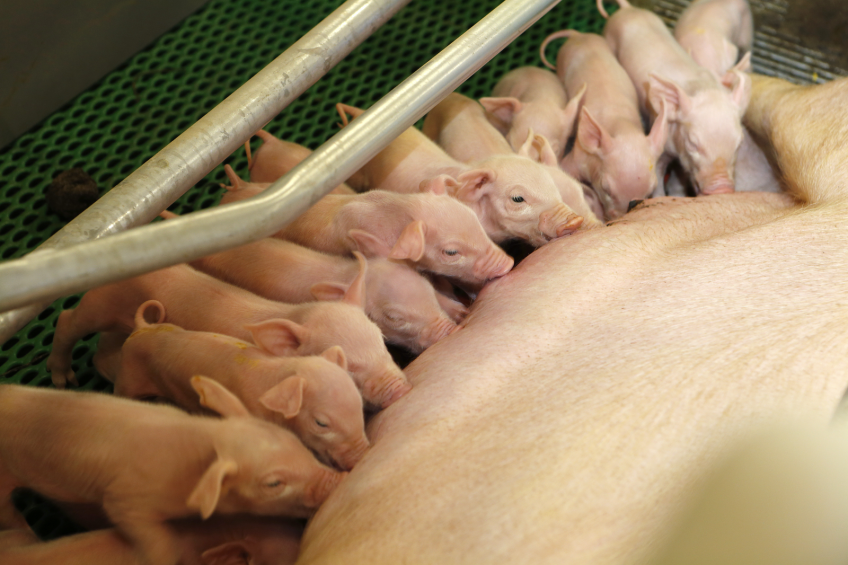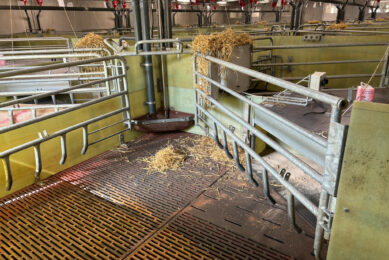Feeding strategies for hyperprolific sows

Due to the enormous increase in liveborn piglets/sow/year, feeding strategies and feed composition are to be adapted to the different phases of the cycle to guarantee a high lifetime performance. For sows, up to four to six diets are ideal.
By Jacob Dall, Karsten T. Rasmussen and Arndt Schäfer, Vilofoss*
A sow is going through different phases during the production cycle: Implantation, midgestation, late gestation, pre-birth, early lactation, and lactation itself, succeeded by a preparation of a next cycle, which starts with insemination.
Through the phases, energy and nutrient requirements as well as the feed intake ability change. Optimally, the feed and feeding strategy should change as well through these phases, but most farms have difficulties feeding more than two diets: one in gestation and one in lactation. Because of this, the actual composition of the feed has to be a compromise.
In addition, technical restrictions in some systems imply that the level of feeding only can be controlled on a group basis.
On top of that – feeding sows is more than supplying them with nutrients.
It also affects the foetus implantation, development and growth, colostrum production and milk production.
Feeding gilts: Preparation
Feeding the young, non-mature gilts is an issue that too many farmers do not give enough attention to.
Contrary to grow-finishers, gilts ought to be fed in a way that help them to become robust, developing strong legs and joints and a moderate backfat level. In addition, feeding has to support the development of their reproductive tracts. To do this, the focus has to be on moderate growth levels, starting at 50-60 kg live weight, with vitamins and minerals similar to those of a lactating sow. To limit growth and develop appropriate backfat levels, energy supply has to be moderate and protein supply must be limited at 80-90% of a grower diet.
Body condition
Keeping the right sow body condition in all stages is essential to maximise productivity at the most efficient utilisation of feed, hence minimising the feed consumption. It is customary to evaluate sows when exiting the farrowing unit. Optimally, however, a body condition scoring should be done just after insemination, and one or two times during gestation. These scorings enables the farm manager to adjust the feeding level and reach appropriate sow weight and body condition when entering the farrowing unit. The right body condition which will lead to a good appetite, that in combination with a moderate weight loss, will provide the best conditions for optimal milk production.
Vilofoss’ recommendation is to have four feeding curves during gestation:
1. Gilts/non-mature sows;
2. Skinny sows;
3. Normal sows;
4. Fat sows.
Especially when determining the feeding curve for the skinny sows, it is important to be aware that the FCR of sows is very low. To put on 1 kg of body weight, a sow has to eat an extra 4-5 kg of feed. A lactation body weight loss of 40 kg, will lead to a needed feed consumption of about 180 kg extra in the following gestation, meaning that the sow has to increase feed intake by more than 1.5 kg/day on average.
Body condition scoring cannot be done only visually. It is crucial to feel ribs, spine and hips, to determine the backfat level. Using a backfat scanner permits a more objective and standardised way of scoring. Keeping sows in the appropriate body condition in all stages of the reproductive cycle improves both sow productivity and longevity and keeps the feed costs at a minimum.
Jacob Dall, Vilofoss: “Feeding sows is more than supplying them with nutrients”.
Phase requirements
Implantation
During implantation (approximately from days 7-20), the foetuses are attached in the uterus. Feeding, as well as other management and housing issues, should aim to implant the maximum number of foetuses. Also in this phase, the body condition has to be addressed. If the sow lacks body weight, this is the time to start feeding extra, that will bring the sow up to the desired weight before entering the farrowing unit. It has to be considered that gilts should not get too much feed the first 5-7 days after insemination.
Mid-gestation
Feeding should primarily aim at fulfilling the maintenance needs of the sow. Only limited nutrient supply is needed for the foetuses, although focus should be on balancing the energy/nutrient ratio to avoid insufficient nutrient supply if feeding low-energy feed.
Entering mid-gestation, a (new) body condition scoring is needed, in order to reassess the level of feeding. As the needed feed allowance is much lower than the voluntary feed intake of the sow, in this phase it is possible to put on considerable body weight. Some farm managers tend to over-feed the sows during mid-gestation, which leads to increased feed costs and tends to negatively affect productivity. It depends on the replacement rate of the farm how many first parity sows are in the herd and whether it is necessary to have a dedicated diet for the younger animals.
Late gestation
As from 28 days pre-partum, foetuses start growing, and as from 21 days pre-partum the udder starts preparing for lactation, laying the basis for good colostrum production. Experience shows that increasing the amount of feed, to a level around 3.5 kg/sow/day, for the last 28 days pre-farrowing assures sufficient nutrients for the growth of the foetuses to achieve the desired birth weight.
With the ongoing genetic improvement and litter sizes growing, the average piglet birth weight has come down. As birth weight is closely related to survival of the piglets within the first couple of days post-partum, large efforts should be put into securing optimum conditions in this time frame.
Not only birth weight influences the survival of the piglets but also parturition time. For instance, special diets for birth preparation show faster births and less problems with mastitis, metritis, agalactia (MMA). Supplying a special mix of glycerol bound fatty acids named SowCid from 21 days pre-partum has shown to improve colostrum quality and increase piglet vitality. This corresponds to the amount of colostrum consumed per piglet, thereby decreasing overall mortality.
Early lactation
Feeding in early lactation has to focus on optimising the colostrum production, and increase feed intake, without inducing a loss of appetite. The addition of medium-chain fatty acids positively affects the colostrum quality. Recent research shows that adding soluble, fermentable fibres to the diet all contributes to improved piglet survival and weight gain during the first days post-partum. Danish experience shows that feeding a protein level equal to the gestation diet up to three to four days post-partum tends to prevent neonatal diarrhoea.
Lactation
During lactation, feed intake has to be in focus, as well as the nutrient content of the feed. If the strategy involves limited protein level within the first days after farrowing, the protein level should be increased in the actual lactation feed. There are some national differences regarding experience of the right protein level of lactation feed.
Often, when increasing feeding levels too aggressively, the sows will stop eating, with regaining the appetite being very difficult. Increases should be made insteps of about 0.5 kg/day, till reaching the maximum level of about 8-9 kg/day. Some sows are capable of eating 10 kg/day or more and could be limited, but a considerable portion of the sows has trouble taking up the needed amount of feed. This problem should be addressed through a strict strategy of feeding the sow slightly below the level of voluntary feed intake within the first few days after farrowing, in general not exceeding 5 kg on day 7.
When the feed intake exceeds 5 kg it is common to feed three times a day to assure a high feed intake. Blindly increasing energy content of lactation feed will not bring the feed (energy) intake to the needed level, as rising
energy content of the feed will require increased added fat, which in an extent of more than 4-5% will not contribute to the daily energy turnover. Instead, the focus should be on the right level of amino acids, high quality cereals, and a starch content of 420-450 g/kg.
Preparation for insemination
Preparation for insemination focuses on maximising the number of egg cells available for fertilisation, and optimum energy status for best heat indication. This all should make it easier to perform insemination at the right time when at the same time, the weaning should inhibit the milk production. A change of feed and so-called ‘positive stressors’ helps in achieving this.
Preparation for the next litter starts in the last phase of the lactation, and can be enhanced using products like SowStimul or Scrofertil, which improve ovulation and contribute to a positive energy status in the sow. Moderate feeding level the first few days after weaning, followed by a few days with a strong increase, possibly with the addition of highly digestible energy in the form of dextrose or alike, together with the proper mating unit management leads to the best insemination.
Then, the cycle starts all over again.
Article featured in AllAboutFeed 22.2
* Vilofoss consists of Vitfoss, Deutsche Vilomix and Calcialiment.











